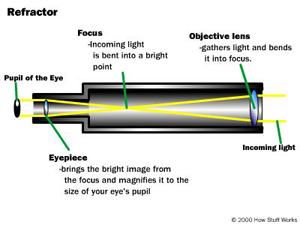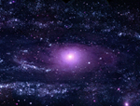Telescopes
A telescope is an instrument that allows you to view far-away objects at a closer distance. Although there are several different types, most telescopes determine images through the discovery of electromagnetic radiation.
Optical Telescopes
Optical telescopes are the most widely used for astronomy. They all use some form of optics, which are elements that manipulate the properties of light. The optics used may include lenses, prisms, and mirrors. Along with other categories, optical telescopes may be further classified as refractors or reflectors.
How Refractors Work

http://science.howstuffworks.com/telescope.htm
26 November 2010
Refraction is how light bends when it passes through a medium. This change of direction is due to a change in the speed of the light wave. A refracting telescope uses this property to collect and magnify light. The simplest of refracting telescopes uses two lenses.
The objective lens is closest to the object you are viewing. The main function of this lens is to gather light for viewing the image. Once a view of the image is captured, it is focused behind the lens. The focused image is then picked up by the eyepiece, which magnifies the image and puts it into focus for you to see.
How Reflectors Work
Reflection is how light changes direction from a medium, back to its original source. The reflecting telescope uses this property to collect and magnify light. One example of a reflecting telescope is the Newtonian telescope, invented in 1668 by Sir Isaac Newton.

As light enters the telescope, it continues until it reflects off of a concave reflector, also known as the primary mirror. The light is then reflected back to a flat reflector, known as the secondary mirror.
Here, the image is passed through the eyepiece lens. This is where the image is magnified and focused, for you to see.
Parameters
There are several parameters used to define telescopes:
- aperture - this is the diameter of the lens closest to the viewing object. Typically in millimeters, this will determine the amount of light the telescope can use to capture the image.
- magnification - this is a measure of how much the visual size of an object is increased when you use the telescope. To calculate the magnification, divide the focal length of the primary optic by the focal length of the eyepiece.
- focal length - this is a measurement of distance between the primary optic and where the image is focused. For reflective telescopes, there is also a focal length for the eyepiece itself.
- f ratio - focal length divided by aperture. The lower the ratio, the brighter images are from the telescope
Finding the Right Telescope
There are several things you should consider when looking for the right telescope:
- aperture - A higher aperture means more light coming in to the telescope. Use a higher aperture to view dimly lit objects, and less of one for bright objects, such as the moon (in some phases).
- high optical quality - Low quality lenses can show imperfections, which can result in an improper view of the object. Usually, the higher the price, the better the optical quality.
- magnification - A higher magnification is not always better. If this value is too high, you could have over focused images. By rule of thumb, the magnification should not be higher than 2 x the aperture in millimeters.
- size - Keep the size of the telescope in mind. Will you be transporting it often, or will it be sedentary? If you will be carrying the telescope around often, you don't want something heavy or cumbersome.
- refractor or reflector
- reflectors are considerably less expensive, because of the optics
- reflectors are typically smaller
- reflectors are usually more stable, due to a lower center of gravity
- unlike refractors, reflector lenses need to be adjusted periodically
- reflectors are not sealed, so you may need to clean the optics on occasion
- reflective lenses may require re-coating, but this is infrequent
What You Can See
What you can see through a telescope is dependant on many features. This includes but is not limited to - the aperture, magnification and type of scope, the condition of the optics, and light pollution. However, listed below are some of the objects you can look for:
- Earth's moon - you can get an excellent view of the moon's craters and mountain ranges. One interesting item to look for is the terminator. Known as the separation between the light and dark sides, this is the place to find a stark contrast in the moon's features.
- planets - you can see more planets and details than with binoculars. Mars and its fascinating landscape is more visible, as are Saturn and its rings. Jupiter and its moons are also more visible.
- star clusters - some are easier to locate than with binoculars. This is where a star-chart definitely comes in handy.
- nebulae - you can look for the Orion Nebula (M42). Located near Orion's sword, this will show up as a glowing, hazy patch. A telescope and a sky with a low amount of light pollution will allow you to see more detail and structure.
- galaxies - check out the spiral-shaped Andromeda Galaxy (M31). This galaxy is located within the constellation Andromeda, below the constellation Cassiopeia.
References
Please visit our references page.




